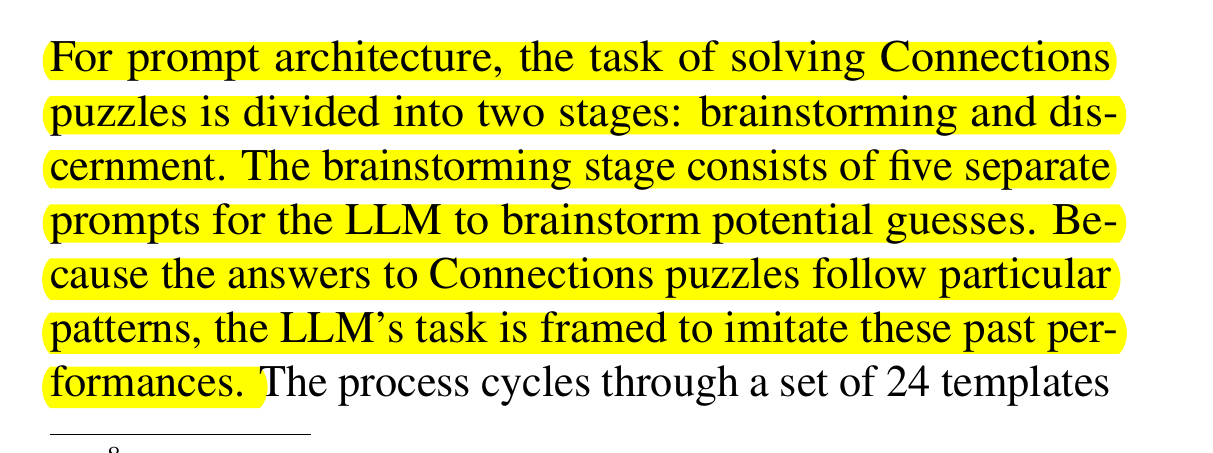Paper Explained: "LLMs as Method Actors: A Model for Prompt Engineering and Architecture"
Treating LLMs as actors unlocks their true potential in complex reasoning tasks.
Core Concept
Acting-based prompting outperforms traditional reasoning approaches for LLMs
🎯 Original Problem:
LLMs struggle with complex reasoning tasks, particularly word puzzles like NYT Connections, where traditional prompting methods achieve low success rates.
Traditional prompting approaches treat LLMs as reasoning engines that need to think through problems systematically. This mental model has inherent limitations. The Method Actor framework introduces a radical shift - viewing LLMs as performers executing dramatic scripts rather than thinking machines.
The fundamental insight revolves around imitation versus reasoning. LLMs demonstrate superior performance when mimicking patterns rather than engaging in actual reasoning. By decomposing complex cognitive tasks into sequences of imitable performances, we unlock significantly enhanced capabilities.
Architectural Components
Script Engineering
Each prompt transforms into a dramatic screenplay, complete with:
Character development
Motivational context
Environmental setting
Precise stage directions
Performance Staging
The framework implements a two-phase execution model:
Phase 1: Brainstorming Engine
The brainstorming phase implements a sophisticated templating system derived from historical puzzle-solving patterns. The system maintains 24 distinct templates, each capturing unique pattern recognition strategies.
The architecture cycles through these templates systematically:
→ Each template targets specific linguistic or semantic patterns from successful past solutions
→ The LLM applies these templates to the current puzzle's word set, generating potential solution candidates
→ Every brainstorming call employs different templates, ensuring comprehensive pattern exploration
A key innovation here: Rather than asking the LLM to reason from scratch, it leverages proven solution architectures, significantly improving pattern recognition efficiency.
Phase 2: Discernment Architecture
The discernment phase implements a multi-stage filtering pipeline:
→ Extract Stage: Reduces information density by isolating viable solution candidates and their underlying rationale
→ Discern Stage: Evaluates potential solutions against historical success patterns
→ Decide Stage: Determines submission worthiness of each candidate
→ Evaluate Stage: Final validation where top candidates undergo rigorous cross-comparison
The system employs sophisticated validation mechanisms:
→ "Mole word" validation: Randomly selected words from correct solutions help detect hallucinated connections
→ Deterministic filtering: Mathematical validation ensures submitted guesses have exactly 1/3 probability of containing mole words
→ Cross-solution coherence: Ensures solutions don't create logical conflicts with previously validated answers
This two-phase architecture addresses a fundamental challenge: balancing creative solution generation with rigorous validation. The brainstorming phase enables broad exploration while the discernment phase implements strict quality controls, resulting in significantly improved puzzle-solving accuracy.
Quick Example of Two-Phase System
Phase 1: Brainstorming
Consider puzzle words: CORN, OLIVE, PALM, PEANUT
→ Template Applied: "Words that belong to the same category" → LLM Performance: "These could be types of cooking oils"
Phase 2: Discernment
The suggested grouping undergoes quick validation:For prompt architecture, the task of solving
→ Extract: Confirms all words can indeed be oils → Verify: Checks against already solved groups → Validate: Confirms no mole words present → Submit: Group meets all criteria for submission
This simplified case shows how the system transforms pattern recognition (noticing they're all oils) into a validated solution through systematic checks. The first phase generates the insight, while the second phase ensures its validity.
Architecture Optimization
The system implements delayed submission protocols until unique solution quadruplets emerge. This prevents common pitfalls like red herring detection and false pattern matching.
🔀 So what is Delayed Submission Architecture concept here
It represents a sophisticated approach to puzzle-solving optimization. Instead of immediately submitting potential solutions, the system accumulates and evaluates groups of possible answers through multiple validation stages.
Implementation Strategy of Delayed Submission Architecture
The system employs a "final guesses" list that collects potential solutions. Here's how it works:
→ When the LLM identifies a potential solution, instead of immediate submission, it adds the guess to a holding list
→ The system analyzes these guesses for unique word combinations - specifically looking for guesses that share no overlapping words
→ A critical threshold must be met before submission: either identifying four completely unique guesses (a quadruplet) or accumulating enough evidence for a particular guess's validity
Validation Thresholds of Delayed Submission Architecture
The architecture implements several sophisticated decision gates:
→ Primary Threshold: Requires a complete set of four guesses with zero word overlap
→ Secondary Threshold: After processing thirteen guesses, allows submission of three unique guesses
→ Tertiary Threshold: Post fifteen guesses, permits submission of any two non-overlapping guesses
→ Frequency Threshold: If the same guess appears three times in the "final guesses" list, triggers automatic submission
Red Herring Prevention of Delayed Submission Architecture
This delayed approach specifically targets a common failure mode in puzzle-solving LLMs. Red herrings often create false connections that look plausible in isolation but fail in the broader puzzle context. By requiring multiple unique, non-overlapping solutions before submission, the system effectively filters out these deceptive patterns.
The architecture essentially forces the LLM to demonstrate solution coherence across multiple dimensions before committing to an answer, significantly reducing error rates in complex puzzle-solving scenarios.
Technical Innovation Stack
Compensation Mechanisms
When imitation fails, the system deploys sophisticated fallback strategies:
Deterministic Logic Gates: Filter implausible connections
Validation Checkpoints: Verify solution coherence
Mole Word Detection: Identify hallucinated relationships
Experimental Validation
Applied to NYT Connections puzzles, the Method Actor approach demonstrated remarkable improvements:
Traditional Chain-of-Thought: 41% success rate
Method Actor Framework: 86% success rate
Perfect Solution Rate: Increased to 87% with GPT-4-preview
Technical Implications
This research reveals a crucial insight about contemporary LLM architectures - they excel at authentic imitation rather than genuine reasoning. The Method Actor framework leverages this characteristic by:
Structuring prompts as dramatic scenarios
Maximizing context window utilization
Implementing multi-stage validation protocols
Deploying sophisticated fallback mechanisms
The dramatic framework approach, rather than traditional reasoning methods, unlocks superior performance on complex cognitive tasks. This suggests a fundamental rethinking of how we should design LLM interaction systems.



